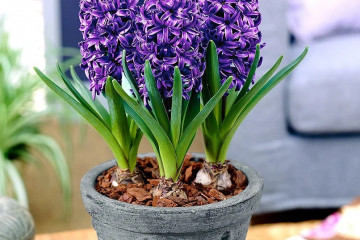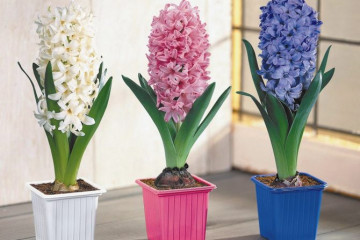Chrysanthemum in a pot - home care
There are many flower crops on sale, but chrysanthemums stand out. Sometimes it happens that a purchased plant at home fades and begins to wither. In order not to ruin the flower, it is useful to navigate how a chrysanthemum grows in a pot. Home care.
Indoor chrysanthemums
Indoor chrysanthemum is suitable for growing at home. For an apartment, just right, a low compact flower.
The following types are popular among flower growers for home growing:
- Chinese chrysanthemums. Distinctive features of the bush - 30 cm shoots, specific aroma of foliage, double flowers. Crop cultivation will open up great opportunities for landscape design.
- Shrub chrysanthemums. Suitable for decorating large rooms. The height of the bushes reaches 1 m. They have erect branched shoots, dissected leaves, flowers gather in large baskets.
- Indian chrysanthemums. They feel great as potted chrysanthemums, do not lose their decorative effect, despite the dry air in the room. They belong to the distant ancestors of small-flowered chrysanthemum hybrids.
- Korean chrysanthemums. Often grown with spherical flower crops.
Chrysanthemum care after purchase
Before purchasing a plant in a store, it must be carefully examined. Choose a strong, healthy shrub, with rich green foliage without spots. A flower with buds is preferable for long flowering at home. Carefully examine the leaves for the presence of harmful insects. Newbies are wondering how to care for a chrysanthemum.
Culture in the new conditions will need to adapt. The bush is placed in a lighted place where the direct rays of the sun do not fall. If necessary, the plant is watered.
After 14 days, after the adaptation of the flower, it needs to be transplanted into a fresh substrate.
Transplanting a blooming home chrysanthemum will have to be postponed until flowering is complete.
Transplanting a plant into a pot
Recently acquired chrysanthemum is transplanted at least 2 weeks later, then young crops - annually, adult plants - once every 3 years.
It is preferable to transplant the flower in the spring. But when the bush grows during the summer season, it is better to plant it in the fall.
To transplant a chrysanthemum, you will need:
- a pot that exceeds the previous container in diameter and length by 2-3 cm;
- neutral soil (acidic soil is not good);
- drainage.
The soil mixture is bought in the store or prepared independently.
Mix components such as:
- garden land and turf - 4 parts each;
- humus and sand - 1 part each.
First, a drainage layer is laid on the bottom of the flowerpot, then a nutritious soil mixture.
For a successful transplantation of the culture and avoidance of stress, chrysanthemum is transferred from dish to dish:
- moisturizing is carried out the day before transplanting;
- taken out of the pot along with an earthen lump;
- placed in a flowerpot on a layer of soil;
- the earth is poured around and over the roots.
The plant is watered and placed in a shaded place for a couple of days. The transshipment method is also suitable for flowering crops.
Experienced florists recommend adding a little bird droppings in the spring when planting room chrysanthemums in the ground. The bush will thank you in the summer with many flowers.
Watering and humidity
Purchased chrysanthemum is watered with care. The flower is picky about moisture. Excess moisture provokes rotting of the root system or infection with a fungus.
In this situation, drainage will help out: a hole is provided in the flowerpot, expanded clay or moss is placed below. A drainage layer is the best solution to remove excess moisture from the container.
Watering plants is carried out a maximum of 2 times a week. They monitor the state of the earth clod, prevent drying out.
Do not use ordinary tap water for irrigation. Passing through the filter and settling for 1-2 days will be required. Cold water is not used to avoid phyto-diseases.
For a flower, high humidity is preferable. Spraying the foliage protects the chrysanthemum from dehydration. Frequent spraying is recommended: 1-2 times daily.
Lighting, temperature control
To bloom profusely, chrysanthemums have enough short daylight hours. During active growth and flowering, they need a sunny location, where they do not suffer from midday rays and are not shaded by plants in the neighborhood.
In winter, plants are kept in dark rooms, with the exception of individuals continuing to bloom. They are transferred to light rooms.
If chrysanthemums grow at home, care involves observing the temperature regime. Heat and direct sunlight have a detrimental effect on flowers. For long-term flowering of chrysanthemums, the optimum temperature is +15 ° С, for normal growth - in the range of +18 ° С.
Top dressing for lush flowering
At home, caring for chrysanthemums involves feeding with fertilizers. A flower in a flowerpot quickly takes nutrients from the soil. The regularity of dressings for full development and active flowering is appreciated. They use mineral fertilizers. Just right monophosphate potassium solution, its deficiency is responsible for why chrysanthemums bloom late.
They are fed with other multicomponent additives that contain:
- potassium;
- nitrogen;
- phosphorus.
During the growing season, adults are fertilized with liquid organic matter every 10 days. When growing a plant in poor soil, feeding with a mullein in a ratio of 1 to 10 is applied every 4 days. Do this before flowering. Removing the plant to the balcony in a shaded place for 1-2 days will relieve the heavy odor of top dressing in the room.
Pruning and shaping the bush
Chrysanthemum is pruned annually. The manipulation is performed when the plant has faded. During the dormant period, in winter, the flower is placed in the cellar. With the arrival of spring, the culture starts up new shoots, so a transplant is appropriate. For adult specimens, the procedure is optional.
For the splendor and beauty of the bush, yellowed or dried leaves and flowers are plucked. Pruning and pinching of the shoots is necessary, which will ensure the growth of the crop in width, and not stretching.
In winter, perennials are pruned before sheltering. The flower is shortened, leaving 10 cm of hemp.
The main problems when growing a plant
Why do the leaves turn yellow
Yellowed foliage does not decorate the bush, it signals a problem.
If the leaves of a flower in a flowerpot turn yellow, possible reasons include:
- Poor drainage. Dense soil is an obstacle for moisture to the roots.
- Cramped capacity. The culture lacks nutrients.
- Diseases - septoria and rust, which are fought with copper oxychloride and Fundazol.
Aphids and spider mites
When pests appear, flower growers eliminate them using folk methods:
- processed with garlic or onion broth;
- cleaned by hand with soapy water;
- pollinate the soil near the crop with tobacco.
Insecticides resist harmful insects.
Appropriate use:
- Fitoverma and Decis;
- Derris and Aktellika;
- Mospilan and Confidor.
The bushes are re-treated after 5 days if the plants are severely damaged.
If a chrysanthemum is damaged by a tick, urgent measures are taken:
- They are removed when watering with a stream of water.
- A soap-copper solution is used, which is prepared from 10 liters of water with the addition of green soap (200 g) and copper sulfate (20 g).
- Efficiency is typical for insecticides: Akarin, Fufanon, Bazudin, Kleschevit.
Chrysanthemum fungal diseases
Gray rot
Fungus diseases cause:
- poor air exchange;
- increased acidity of the soil;
- excess nitrogen in the soil;
- heat.
The manifestation of the disease is spotting on the lower leaves, which are distinguished by a yellow color, after which they turn into brown and black, increasing in size.
Cutting and destruction of infected leaves will be required. Prevention provides for the regularity of cleaning and destruction of plant residues at the summer cottage. When the infection spreads, they use fungicides.
Rust
Symptoms of the disease are pale areas on the leaf surface, mealy red-orange blotches on the underside of the leaf.
Fight rust as follows:
- The infected foliage is removed.
- Thin shrub plantings to provide ventilation.
- Do not allow water to enter the chrysanthemum when watering.
Also, in order to save the plants, they resort to fungicides if the phyto-disease becomes widespread.
Fusarium
Yellowed and brown leaves are signs of infection. Affected crops are lagging behind and often do not bloom. The fungus entering the flower from the soil through the root system inhibits the flow of water into plant tissues.
In resisting the disease will help:
- removal of affected parts of cultures;
- planting varieties resistant to wilting;
- in the presence of the Fusarium fungus, it is desirable to increase the pH of the soil, which is 6.5-7.0.
Powdery mildew
The disease is characterized by the coating of leaf plates with a gray-ash powdery bloom. Fungal spores like a humid atmosphere - this is a prerequisite for reproduction.
In the battle against infection, they use:
- elimination of contaminated floral material;
- fungicides.
Reproduction of potted chrysanthemums
Chrysanthemums breed:
- Seeds. They are characterized by good germination, prolonged waiting for flowering.
- By dividing the bushes. Reproduction is performed with the onset of the spring season or after flowering.
- By cuttings. The right time to plant the shoots is summer, spring. Rooting of 10 cm of apical cuttings takes place in water or in moist soil. You will need to plant 2-3 individuals in a container. When rooting in the ground, the process is covered with a bag or glassware. The moisture of the earth is checked daily and the planting material is aired. The restoration of foliage elasticity indicates the survival of the cutting and the need to remove the shelter. To stimulate the growth of shoots, pinching the top of the plant is carried out.
If chrysanthemums are cultivated in pots, how to care at home, advice from florists will help. Compliance with the rules will give joy and pleasure from the beauty of the flower.























